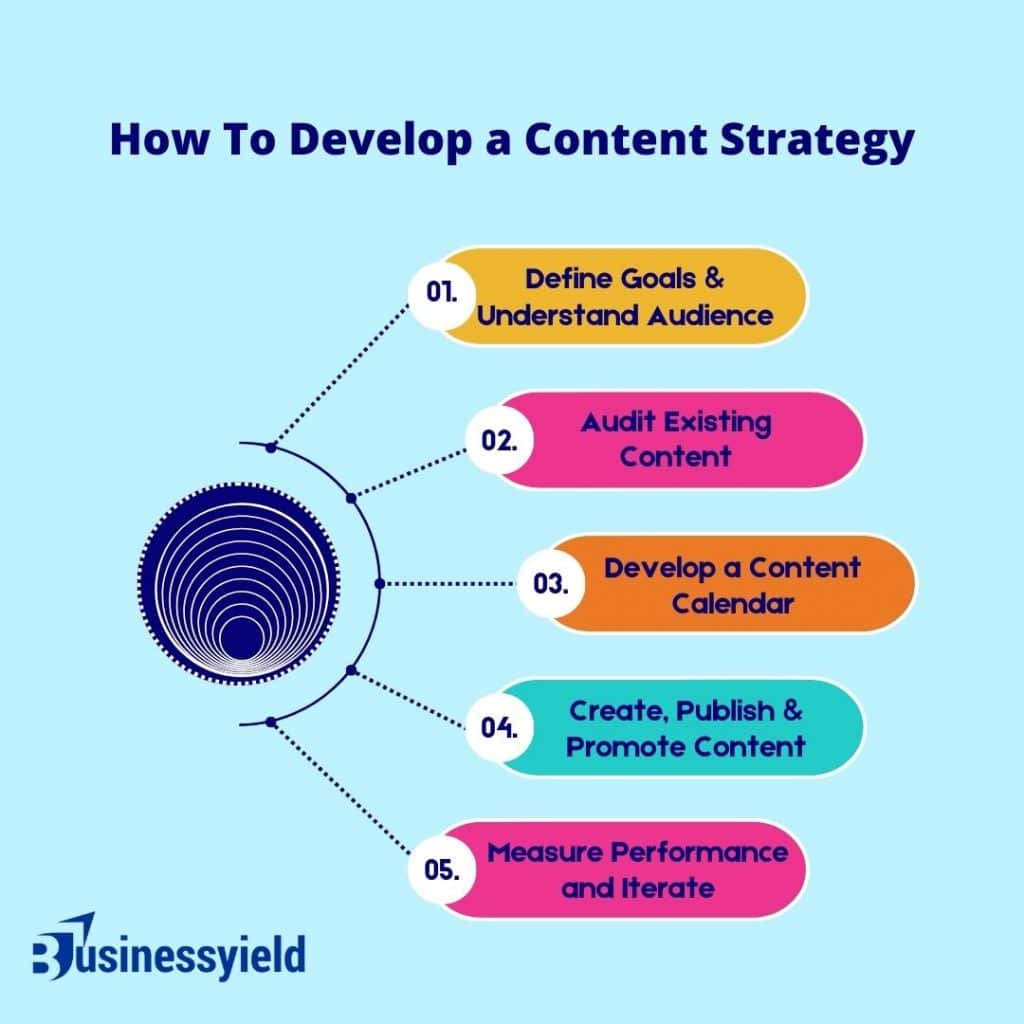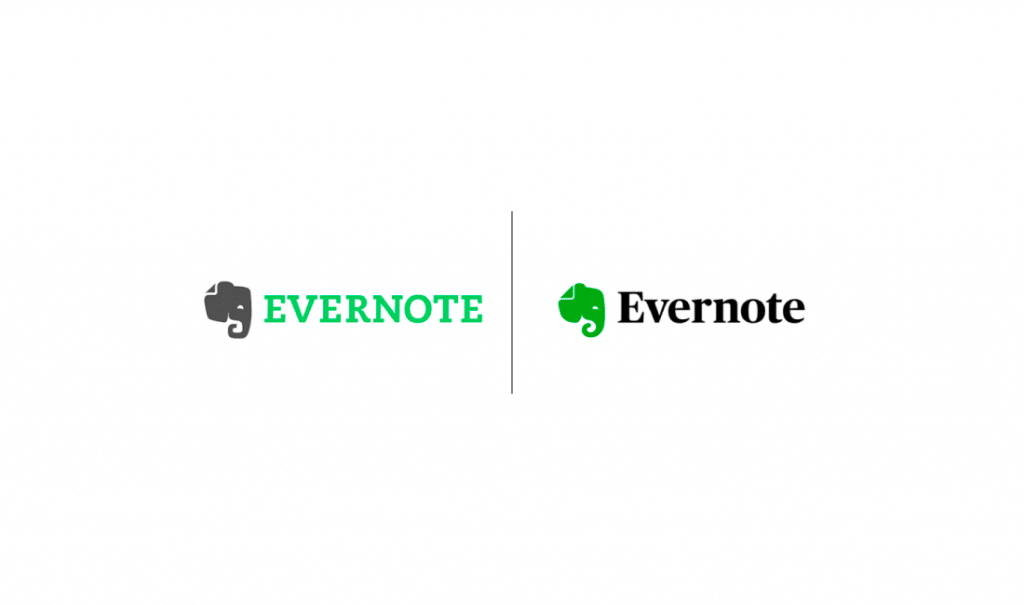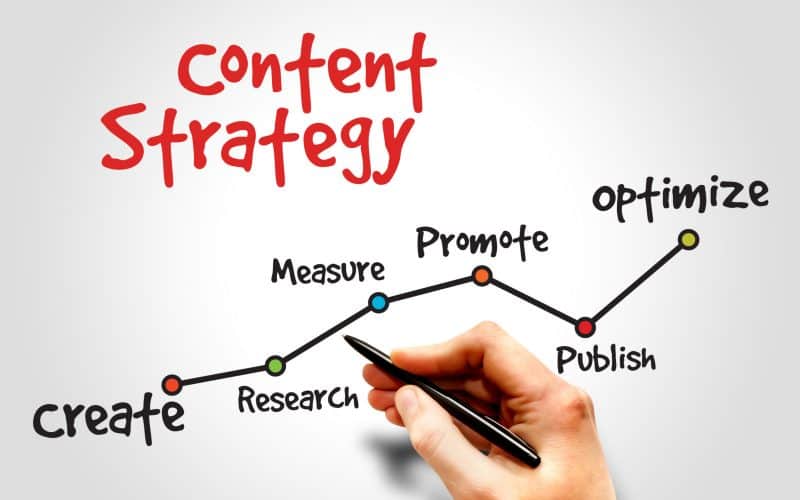Do you recall that small shop on the corner that you used to visit often when you were younger? Is it the one with the slightly chipped awning and shelves filled with familiar treasures? Despite lacking a flashy website or a large social media following, they consistently captured your attention. Why, may I ask? They possessed a rare quality that is often absent in modern businesses: a sincere bond with their customers, forged over many years of comprehending their desires and requirements.
That’s the beauty of exceptional content marketing. It’s not just about bombarding people with sales pitches; it’s about fostering connections, crafting narratives that strike a chord, and subtly positioning your brand as the solution to their deepest desires.
In this post, we’ll explore the concept of content strategy, the importance of having a content marketing plan for your business, and the necessary steps to create an effective strategy. Let’s also delve into a few examples of successful content marketing strategies to spark some inspiration. So, what exactly is a content strategy?
What is a Content Strategy?
A content strategy is essentially a plan that outlines how to create, distribute, and manage content in order to achieve specific goals. It involves determining what type of content to produce, who the target audience is, and how to effectively deliver the content to them. It also involves analyzing and measuring the success of the content strategy to make improvements over time. In short, a content strategy is a roadmap for creating and sharing content that aligns with an organization’s objectives.
Think of it as a roadmap that helps you navigate your content creation efforts. The plan is quite thorough and covers all aspects, including:
- Who is your target audience?: Let’s talk about your ideal customer, their needs, and how we can help solve their problems.
- What you will create: There are various forms of content, including blog posts, infographics, videos, and podcasts, that can effectively engage your audience.
- Where will you be publishing? Where your audience spends their time depends on the various channels and platforms.
- How success will be measured: Tracking key metrics is crucial for evaluating the effectiveness of your content and making necessary adjustments. By monitoring these metrics, you can gain valuable insights into how your content is performing and identify areas for improvement. This data-driven approach allows you to have meaningful conversations about your content strategy and make informed decisions to optimize its impact.
Let’s consider it from a different perspective.
When you have a good understanding of your audience and what they are looking for, you can create content that is meaningful, useful, and interesting. Building trust and loyalty is crucial to establishing strong relationships with customers, which ultimately translates into increased conversions and sales.
Why Do You Need a Content Strategy?
Having a clear content strategy provides several benefits:
- Focus and direction: This ensures your efforts are aligned with your overall marketing goals.
- Consistency and quality: This helps you create high-quality content that resonates with your audience.
- Improved ROI: It enables you to track the effectiveness of your content and optimize your spend.
- Competitive advantage: It helps you stand out from the crowd with unique and valuable content.
When we embarked on a journey to connect with our eco-conscious audience for our handmade home decor blog, we revamped our content strategy to offer more than just products—we shared stories. Through our blog, we take you behind the scenes, unravel the inspiration behind each handmade item, and delve into the heart of sustainable living. This personalized approach not only reflects our commitment to eco-friendly practices but also resonates with our customers on a deeper level. The result? It is an enriching experience for our audience, translating into increased website traffic, heightened brand loyalty, and a noticeable boost in sales.
Here I’ll give a detailed guide on developing this winning strategy. First, let’s look at the basic components of an effective content strategy.
Key Components of a Content Strategy
These components are vital in creating a cohesive and impactful content plan. Let’s explore them further.
By implementing a well-defined content creation strategy, you will effectively engage with your audience and successfully meet your business objectives.
A content strategy framework consists of four essential components that play a crucial role in its effectiveness. Let’s explore these components and understand their significance.
#1. Business goals and metrics
A content strategy plan cannot thrive in isolation. It’s crucial to have a clear understanding of your company’s goals for the next 6 to 12 months. What are the key objectives that need to be accomplished? How can content marketing assist you in achieving that goal?
Your content strategy should ensure that all your marketing efforts are moving in the same direction and remain aligned with your goals.
Once you have a clear understanding of your main objectives, it is important to consider the metrics used in content marketing to evaluate performance.
Read Also: Key Performance Indicators KPIs: 145+Examples of KPIs
#2. The audience profile.
To thrive in content marketing, it is crucial to have a deep understanding of your target audience. This knowledge will enable you to create content that resonates with them and drives success.
To truly understand your customers, it’s important to go beyond just knowing their demographic information and buying behavior patterns. It’s crucial to have a deep understanding of their goals and pain points.
It’s important to consider the context and the questions that need to be addressed.
This will help you create a content strategy and content plans tailored to your customers’ needs. Over time, this will help ensure that your content connects with your audience and that your resources are used effectively.
#3. Production and content management plans.
Content management is an essential component of the overall strategy. It covers various aspects of the production process, including:
- How do you plan on creating the content?
- Who will be responsible for writing and designing it?
- Who will make sure that it is of the utmost quality, properly optimized, and prepared for publication?
- Who is in charge of creating an editorial calendar and ensuring the timely completion of tasks?
- Where will your content be published and in what formats?
Ensuring that your content reaches the right audiences is crucial. To achieve this, you will have to implement various strategies to maximize the visibility and engagement of your content. By conducting thorough market research and audience analysis, we will identify the demographics, interests, and preferences of your target audience. This will enable you to tailor your content to their specific needs and preferences.
#4. Budget and team
Make sure to establish a budget for content strategy, production, and promotion. Make sure to consider these factors before diving headfirst.
Once you have finalized your content strategy, it’s time to shift your focus toward creating an action plan and implementing the necessary tactics. Your tactics are how you will implement your strategy with precision and effectiveness.
Let’s discuss how you, as a smart business owner, can create a content strategy that achieves this goal.
Steps In Developing a Content Strategy

Step #1: Define Your Goals and Know Your Audience:
Set specific objectives for your content (for example, increasing brand exposure, increasing sales, or increasing interaction). Concurrently, undertake extensive audience research to gain a better understanding of their preferences, challenges, and habits. Create buyer personas to help you create content.

Step #2: Examine Existing Content and Choose Appropriate Channels:
Conduct an audit of existing content to determine its effectiveness. Then, based on your audience analysis, select the best forms of content (such as blogs, videos, and infographics) and distribution channels (such as social media, email, and your website).
Step #3: Create a content calendar and a production workflow
Create a content calendar that details when and what you will post. Create a streamlined content production process, including stages from concept to publication, and assign roles and duties.
Read Also: What Is A Content Calendar? A Guide For Nigerians
Step #4: Content Creation, Publication, and Promotion:
Create high-quality, engaging content that is tailored to the interests and demands of your target audience. Publish your material regularly and utilize a variety of promotion techniques to expand its reach and visibility.
Step #5. Iterate and measure performance:
Track the performance of your content against your objectives using analytics tools. Examine important indicators such as engagement, traffic, and conversion rates. Use these data to fine-tune your plan, testing with various content types and approaches to maximize effectiveness.
This simplified method allows you to focus on the most important areas of content strategy while remaining flexible enough to adapt and change based on performance and audience feedback.
Here’s a little secret that many websites tend to overlook:
- Emphasize the importance of creating content that remains relevant for an extended period, even after it has been published. While listicles and trend jacking can provide a temporary boost in traffic, it is the comprehensive guides, tutorials, and thought leadership pieces that can attract readers over the long term.
- Give your content a fresh new look and purpose. Explore how we can transform different types of content to suit different platforms. We can convert a blog post into a video script, ensuring that the information is presented conversationally and engagingly. Similarly, we can take an infographic and create a visually appealing social media graphic that captures the key points. The versatility of content allows us to adapt and repurpose it to reach a wider audience. Get the most out of your content assets.
Questions to Ask When Creating a Content Strategy
It’s important to consider a few key questions when developing a content strategy. Let’s explore those topics.
#1. Who is your target audience?
Your content should be designed to reach a wide range of individuals interested in engaging in meaningful conversations. We aim to create content that appeals to a diverse audience and encourages open dialogue. How many different groups of people are you creating content for?
Your business can have different types of customers, and your content strategy can be tailored to cater to different types of users as well.
By utilizing different types of content and channels, you can effectively deliver personalized content to each individual.
Read Also: Target Audience: How to Find & Communicate With Them Effectively (+ Real Examples)
#2. What issue are you aiming to address for your audience(s)?
Ideally, the product or service you offer addresses a problem that your audience may be facing. Your content serves as a guide, helping your audience recognize and tackle the problem at hand. It engages in conversation, coaching, and educating them along the way.
A solid content strategy caters to both newcomers who are exploring their main challenges and existing users who rely on your product to overcome these challenges.
Your content serves to strengthen the solution(s) you are presenting and aids in establishing credibility with your intended audience.
#3. What sets you apart from others?
Your competitors probably offer a product similar to yours, so it’s important for your potential customers to understand what sets yours apart—or, at the very least, what makes it different.
Maybe you possess a distinct brand voice that sets you apart from your rivals.
To demonstrate your value as a seller, it is essential to establish your credibility and convince others that you are worth paying attention to. Make sure to incorporate that message into your content.
#4. Which content formats are you planning to prioritize?
In order to determine which formats to prioritize, it is important to engage with your audience in a way that resonates with them.
Before diving into the world of podcasting or starting a YouTube channel, it’s important to consider where your audience resides. While these platforms have experienced significant growth in recent years, understanding your target audience’s preferred platform is crucial.
Creating content that fails to reach your audience or capture their attention can be a waste of time. It’s important to ensure that the content you produce is engaging and resonates with your target audience.
Let’s begin by selecting the most suitable formats for your strategy. After that, we can work on creating a budget to determine the resources needed to implement it.
#5. Which channels are you planning to publish on?
There are multiple channels available for publishing your content, ranging from your website to social media platforms. You have the flexibility to create content in different formats and distribute it across these channels.
This section of your content strategy will once again highlight the platforms where your audience is most active. Consider publishing your content on YouTube if your audience enjoys longer videos. For a younger audience that prefers fast-paced content, TikTok and Instagram are great options.
Read Also: The Imperative of Using Content Distribution Channels
#6. How do you plan to handle content creation and publication?
Creating and publishing content can feel overwhelming at times.
Before proceeding, it is crucial to clarify the individuals involved and their respective roles in the creation process.
- Where will it be published?
- When will it be going live?
In a small team, it can be relatively straightforward since you may be the only one making decisions. As your company expands, it may become necessary to work together with multiple content teams to develop an efficient process.
Content strategies today focus on managing content from a topic standpoint, which helps prevent clutter. When you create a content editorial calendar centered around topics, it becomes easier to visualize your company’s message and establish yourself as an authority in your market over time.
You can use this checklist below as a guide while planning your content strategy.
Examples of Effective Content Strategies
Let’s delve into some real-life examples of content strategies that are aligned with various business goals to gain a better understanding of what a content strategy entails.
Let’s begin with Evernote, a note-taking app that implemented a content strategy focused on search engine optimization to draw in new potential customers to their website.
#1. Evernote

I really enjoy reading Evernote’s blog because it provides a lot of valuable information about productivity. The blog post, “How To Stay Disciplined When Times Are Tough,” had me in stitches and motivated me to jot down my favorite tips.
Why would a company that sells a note-taking app be discussing discipline?
I discovered their website while searching on Google for tips on staying disciplined.
If you’re into reading about productivity, chances are you’ll also be interested in downloading Evernote’s note-taking product.
However, if Evernote’s marketing team were to create content solely to boost traffic, such as publishing an article titled “Our 10 Favorite Beyonce Songs,” it would not be considered a content strategy. It would simply be content without a strategic purpose.
The alignment of content with business goals is crucial for a successful strategy. Evernote’s strategy involves aligning their content, such as blog posts on productivity, with their business goal of attracting leads who are interested in note-taking to their site.
Let’s explore another example to understand how a well-crafted content strategy can benefit businesses by boosting sales.
#2. Wistia

Imagine this situation: The sales representative at Wistia receives a call from a prospect who has inquiries about Wistia’s video hosting service. The Wistia sales rep discovered during their conversation that her business is utilizing several other tools, such as Intercom, to effectively convert leads into sales.
Sure thing!
After the call concludes, the sales representative takes the initiative to send the prospect a friendly follow-up email. In the email, they share a blog post that highlights the seamless integration between Wistia and Intercom. This integration empowers Intercom users to enhance their communication with prospects by leveraging the valuable video-watching data collected through Wistia.
This is a great example of how a content strategy can be used as a tool to enable sales.
At first glance, it may appear unusual that Wistia has dedicated content about another business tool. This content is a valuable resource for Wistia’s sales team, especially when prospects have questions about how Wistia’s product can work with their current software or processes.
Let’s now delve into content tactics after exploring a few examples of content strategies.
Effective Tactics for Creating Engaging Content
Developing a content strategy requires careful consideration of various factors. Here are some key points to remember:
- Define your goals: Clearly outline what you want to achieve with your content strategy. This will help you stay focused and measure your success.
- Know your audience: Understand who your target audience is and what they are looking for. Tailor your content to meet their needs and preferences.
- Conduct research: Stay updated on industry trends and gather insights about your competitors. This will help you identify gaps and opportunities in the market.
- Create valuable content: Focus on providing high-quality, informative, and engaging content.
Here are a few more things to consider:
- Prioritize quality rather than quantity: Creating one piece of high-quality content that deeply connects with your audience is far more effective than producing ten average pieces that go unnoticed.
- Have a genuine and open conversation: Allow your brand’s unique personality to come alive in your content. Customers are more likely to engage with businesses that come across as authentic and relatable.
- Be patient and persistent. Developing a fruitful content strategy requires dedication and a considerable amount of time. It’s important to stay patient and not lose hope if you don’t see immediate results.
- Have fun! Creating content should be a fun and pleasant experience. Feel free to let your imagination run wild and try out various formats and styles.
Conclusion
Are you feeling a bit overwhelmed? You don’t have to do it all by yourself. With the help of our marketing strategy at BusinessYield, you can develop a content strategy that is data-driven, targeted, and suited to your particular objectives. Let us assist you in finding the most suitable channels, crafting engaging content, and monitoring your progress at every stage.
Keep in mind that content marketing is a continuous process rather than a final goal. Let’s fully embrace the process, try new things, enjoy ourselves, and, above all, keep expanding our knowledge. By adopting a strategic approach, you have the potential to cultivate a dedicated community, entice fresh clientele, and position your brand as a respected authority in your field.
So, are you ready to start telling your story?
- FACEBOOK CREATOR STUDIO: Eligibility & What You Should know
- DIGITAL CONTENT: Meaning, Strategy, Management & Marketing
- MARKETING STRATEGY: What It Is and How to Create One
- How to Publish A Book On Amazon in 2023: Actionable Steps & Costs






